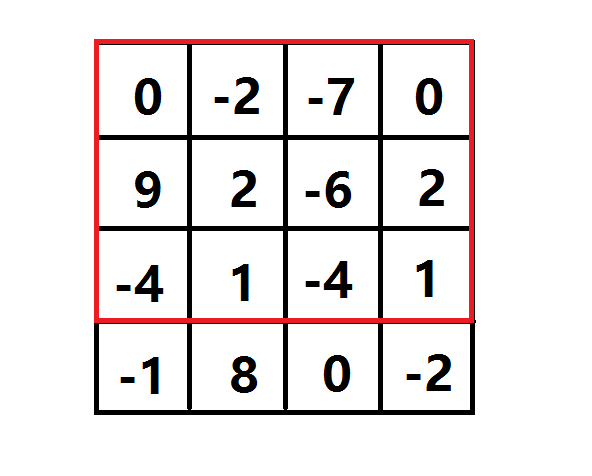NOI题库 1768最大子矩阵 题解
总时间限制: 1000ms 内存限制: 65536kB
描述
已知矩阵的大小定义为矩阵中所有元素的和。给定一个矩阵,你的任务是找到最大的非空(大小至少是1 * 1)子矩阵。
比如,如下4 * 4的矩阵
0 -2 -7 0
9 2 -6 2
-4 1 -4 1
-1 8 0 -2
的最大子矩阵是
9 2
-4 1
-1 8
这个子矩阵的大小是15。
输入
输入是一个N * N的矩阵。输入的第一行给出N (0 < N <= 100)。再后面的若干行中,依次(首先从左到右给出第一行的N个整数,再从左到右给出第二行的N个整数……)给出矩阵中的N2个整数,整数之间由空白字符分隔(空格或者空行)。已知矩阵中整数的范围都在[-127, 127]。
输出
输出最大子矩阵的大小。
样例输入
4
0 -2 -7 0
9 2 -6 2
-4 1 -4 1
-1 8 0 -2
样例输出
15
———————————————————————————————————————
分析
最初看到这道题时,我完全不知道怎么DP,只能想到暴力算法,这道题的最暴力想法就是枚举,但是这个想法的时间复杂度达到O(N^4),当数据较大时无法承受,经大神指点得知,可以使用动态规划解决这个问题。那么,怎么用动态规划呢?
最初学DP时,有一个求最大子段和的问题,可以通过DP解决,最大子矩阵只是最大子段和在二维中的扩展,为了能继续使用这种方法,我们需要将这个矩阵降维处理,降维操作如下图:
这是样例中4*4的矩阵,红色框中是进行降维操作的矩阵


降维的操作很简单,只需要将同一列的加和,就能得到目标序列,我们可以使用前缀和思想来优化这个操作。
通过这个操作可以将二维矩阵降维,随后就可以用区间DP的方法解决这个最大子矩阵的问题。
代码如下:
1 #include "cstdio" 2 #include "cstring" 3 #include "algorithm" 4 #include "cmath" 5 using namespace std ; 6 7 int gmax( int a , int b)//求最大值 8 { 9 return a > b ? a : b ; 10 } 11 12 int best[110], temp[110]; 13 14 int tmp[110][110], pr[110][110]; 15 16 void Init ( int n ) 17 { 18 for( int i = 1 ; i <= n ; ++i )pr[1][i] = tmp[1][i] ;//pr[]数组用前缀和思想 19 for(int i = 2 ; i <= n ; ++i ) 20 for (int j = 1 ; j <= n ; ++j ) 21 pr[i][j] = pr[i - 1][j] + tmp[i][j] ;//计算前缀和 22 return ; 23 } 24 25 int solve ( int *a , int N) 26 { 27 28 memset ( best , 0 , sizeof(best));//best数组表示以i为结尾的最大子序列和 29 int ans = -2147483647 ; 30 for ( int i = 1 ; i <= N ; ++i) 31 { 32 if ( best[i - 1] + a[i] > a[i]) 33 { 34 best[i] = best[i - 1] + a[i] ;//DP方程 35 } 36 else 37 { 38 best[i] = a[i] ;//DP方程 39 } 40 } 41 for ( int i = 1 ; i <= N ; ++i )ans = gmax( ans , best[i]);//求出best数组中的最大值,即最大子序列和 42 return ans ; 43 } 44 45 int main ( ) 46 { 47 int ans = -2147483647 , n; 48 scanf("%d", &n); 49 for(int i = 1 ; i <= n ; ++i ) 50 { 51 for (int j = 1 ; j <= n ; ++j ) 52 { 53 scanf("%d", &tmp[i][j]); 54 } 55 } 56 Init ( n );//预处理 57 for ( int i = 1 ; i <= n ; ++i) 58 { 59 for ( int j = i ; j <= n ; ++j ) 60 { 61 memset( temp , 0 , sizeof(temp)); 62 for ( int k = 1 ; k <= n ; ++k ) 63 { 64 temp[k] = pr[j][k] - pr[i - 1][k];//temp数组是降维后的数组 65 } 66 ans = gmax(solve ( temp , n) , ans );//求出最大值 67 } 68 } 69 printf("%d ", ans); 70 return 0 ; 71 }
——————————————————————————————————————
(完)